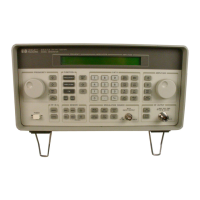External Modulation
Input Level Status
External modulation input level status may be queried for high, low
or input level correct. The instrument automatically detects the input
level
(1
Vpk into
600
ohms for full scale modulation) and displays
the result on the front panel display but must be queried for HP-IB
reporting.
Example: Check the
Condition
of
Modulation
Input
(High
or
Low)
18
OUTPUT
71’3;
“STHT: QUES:
MEID:
tZtItt.iD?”
28
Et.jTER
719;
$'slue
48
IF
Mod=l
THEN PRIt4T
“Ext.
Mcld.
Input.
Hi&I”
Eu8
IF
tlolj=2
THEt.4
F‘FIItJT
”E;.:t..
MI:I!~.
Input.
LI:zI.,.I”
38
tli:i!j=B
I
t.jHt.IL1
1
IJE.
1
58
rloid=B
I
t.IHt.ID
I::’O).~
1
IJe
9
2)
78
Et.jK1
Line
10
Queries the condition of the MODulation register.
Besides querying the condition you may also query
if an event has occurred, such
as
the external
modulation input being high or low
at
some previous
time. Replace the COND? with EVEN? to read the
event status. Reading the event status clears the
register.
Enters the condition of the MODulation register into
the variable “Value”.
Uses the HP Basic command, BINAND to check the
contents of bit
0
in “Value”. If bit
0
is
a
“1”
it will be
reported
as
a decimal equivalent
“1”
and “Mod” will
equal
“
1
”.
Checks if the MODulation condition is
‘I
1
” and
if
true,
prints that the external modulation input
is
high.
Uses the HP Basic command, BINAND to check
the contents of bit
1
in “Value”.
If
bit
1
(decimal
equivalent
“2”)
is
a
“l”,
“Mod”
will equal
“1”.
Checks if the MODulation condition is
“2”
and
if
true,
prints that the external modulation input is low.
Line
20
Line
30
Line
40
Line
50
Line
60
HP-IB Programming
2-9

